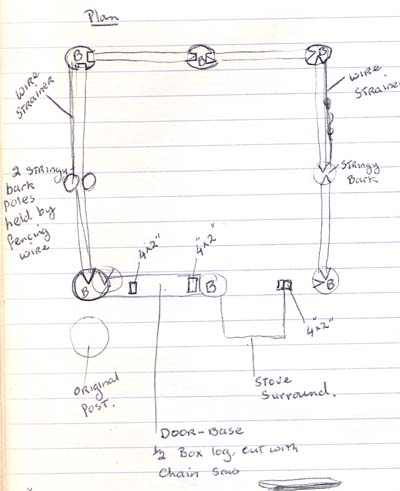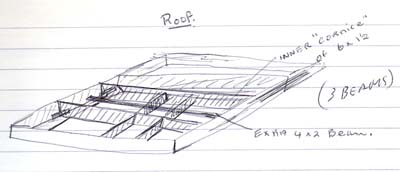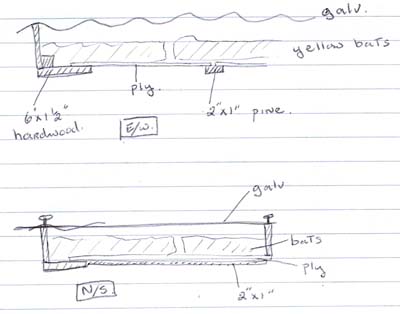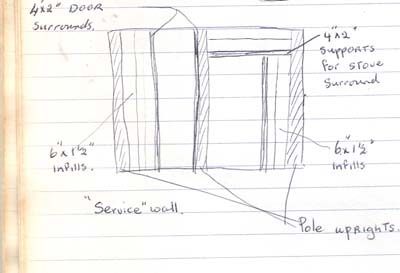Since June 14th, we had held an exhibition in Canberra* and had applied for pumping rights on Sheepstation Creek and a licence to occupy the Crown Lands along the creek. We arranged to meet the Crown Lands officer at our next visit. We had also written to the Frosts Commission asking them to remove signs which might make Richards Track and the Boonabirrah track appear to be public roads. We rang the local Forestry Officer and told him that we would be at the property on July 29th. The signs were removed in the meantime. We had briefed counsel to find the details of access rights. We had been told by phone (by P- L- that the rack along the existing road easement had been bulldozed and that we therefore had a track along the road easement as far past the North turn towards Sheepstation creek. D- L- had agreed verbally to allow us access through his land until such time as the council gets around to putting in the road.
On Thursday July 29th we set out for 5 days to get the hut finished. The children were taken out of school for the trip. We arrived early Thursday afternoon (for lunch) and after setting-up camp at the prepared camp-site began the work of completing the hut. We had brought with us roofing-iron, ply, insulation bats, fibreglass (for a skylight) and a pre-formed [sheetmetal] stove surround for the little “Lux” [see next post for details of the stove]. We hoped to be any extra timber needed at one of the local saw-mills. The newly-cut track was soft but negotiable – the major problem seemed to be an area of red clay just in from the main gate.
Friday morning was spent on business. We drove to the Omeo Shire Offices with house plans and saw the assistant Shire Engineer, who issued a building permit. On the way back through Swifts Creek we called to see Tom Fitzpatrick at the Crown Land office, discussed gold, fish and noxious weeds, and were told that the Licence to Occupy would come through with no problems. We called at Ezard Timber for some timber and left loaded down with 6″ x 1 ½” [15cm x 4cm] and 2″ x 4″ [approx 5cm x 10cm] to a depth of 6″ across the roof-rac. This was all second grade timber, but perfectly okay for our needs, and cost us $10. After a careful trip back to the old Ensay Road turnoff we unloaded, and carried the timber across Luckock’s paddocks in three trips. The roof rack was cracked back and front as the result of the loading. During the three trips we were followed mournfully and noisly by the cows and calves who seemed sure that w would stop at any time to hand feed them. Davied seemed to have stopped feeding them, although the grass was still low, and new growth was very young and sparse. By Saturday night we had all uprights and fillers in position and the stove surround, supported by 2″ x 4″ timbers, was also in place.

We had been using fires for warmth and some cooking (made and attended by Joseph) and the weather had been cold at night, chilly by day. By Sunday there were irregular gusts of wind, forever changing direction, but mostly from the East (we later learnt that high winds had been prevalent throughout Victoria). Showers were also becoming more frequent, but Sunday was our roof-putting-on day, so we went ahead. The Box uprights were cut level with the chainsaw (using Elsie’s roof as a scaffold) and the timber boxing and beams of 6″ x 1½” were put in position, including the skylight section. An extra beam of 4″ x2″ for fixing purposes was positioned before the ply was attached to the inside of the ceiling, bats placed above it, and finally the iron [sheetmetal] and fibreglass nailed in position. Some sheets had fewer nails, as we looked as if we were going to run out of nails before finishing.
The door (which we had also brought with us) was put in position, and the gaps on the ‘service wall’ filled with ply temporarily so that the children could sleep in the hut for that night. Next morning, the service wall was completed with 6″x1 ½” planks and a bold lock put on the window as well as a temporary lock on the door. We left air-beds and tents as well as tools in the locked up hut.
As well as the building work, we had inspected the Camp flat garden and planted pea seedlings and seeds both in the garden and in a garden bed constructed beside the hut (using compost pile to help make up the soil) Five raspberry canes were planted in the large flat beside the dry wash. No wire was put around either ne planting but leafy gum branches were placed over the pea seeds to protect from frosts.


———
*Note from Miriam: Mum and Dad worked in metals. Dad was a silversmith, working in silver and gold and precious and semi-precious stones – creating jewellery that he loved to refer to as wearable artwork. Mum was a pewtersmith, creating dishes, boxes, vases, jugs, platters and all sorts of decorative items. Both of them were self-taught artisans and had a little bit of fame and recognition for their work in this area in the 70s and 80s. They both created some beautiful things, which were exhibited and sold in a number of galleries around Melbourne. They also ran an annual exhibition in Canberra, at the Civic Centre, and for a couple of years at Malemijo the proceeds from this was our main source of income.



4 Responses to July – August 1976